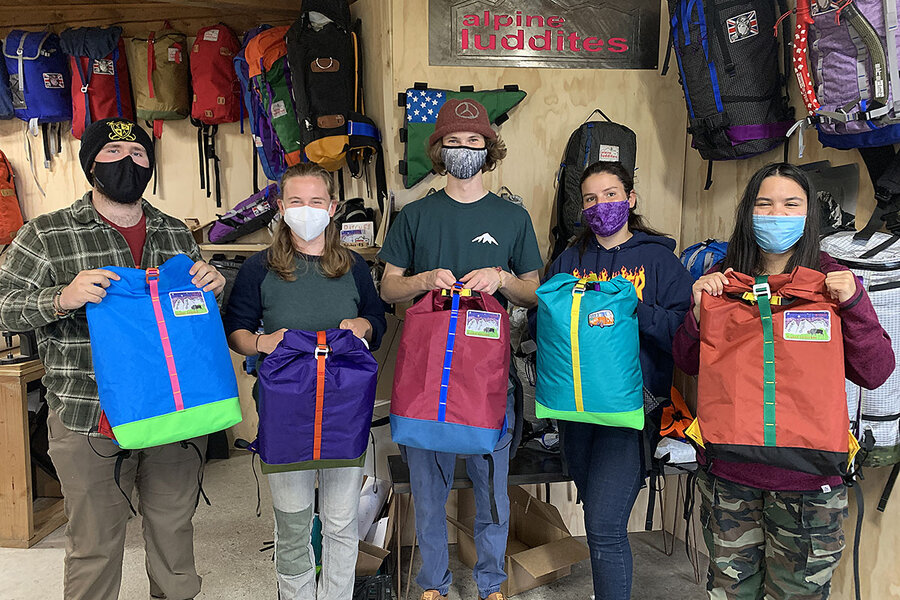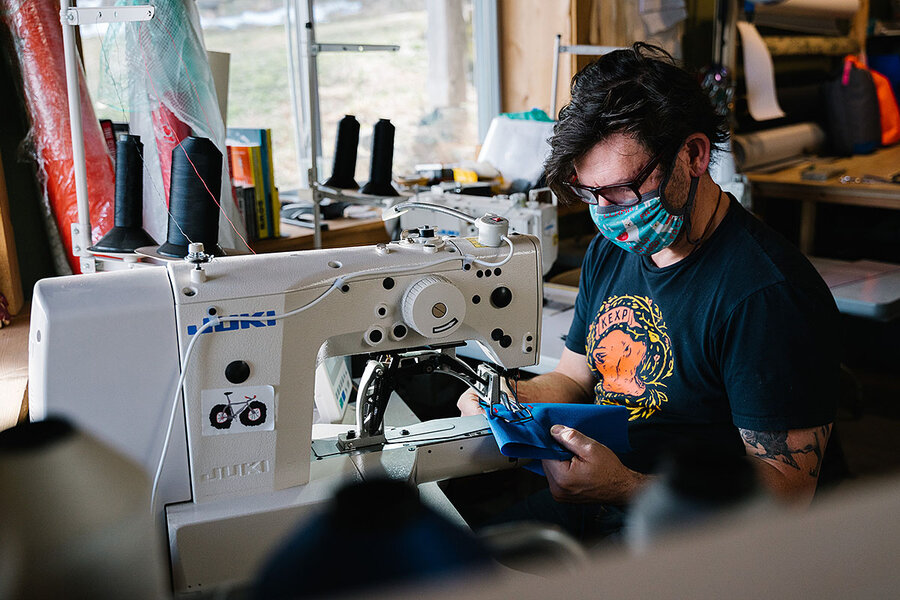Survival skills: A backpack design course helps more than just hikers
Loading...
| Craftsbury, Vt.
This spring, Sterling College in Craftsbury Common, Vermont, offered its first gear design and repair course.
The new class has the potential, say instructors and those in the industry, to not only help students be better prepared for surviving in the wild, but also expand both local gear manufacturing and an understanding of the design process overall.
Why We Wrote This
Sometimes knowledge has a ripple effect. The skills these college students are learning could help keep hiking gear out of the landfill and make outdoor activities more accessible.
“Everything – and I do mean everything – is designed and developed the same way: through a series of steps that visualize, confirm, and then create,” says Kurt Gray, who runs the design and product operation at Jagged Edge Mountain Gear in Telluride, Colorado. “The major benefit to the community,” he adds, “is teaching young people how to realize their dreams through the rigors of meticulous planning and application of skill.”
Guided by faculty and a local backpack-maker, students at Sterling learned in the five-week course how to make a pack from scratch and to repair items brought to them by the college community. They say the course also taught them how to be more discerning consumers of gear, with increased appreciation for what it takes to make the final product.
As Anna Weber-Loomis, an outdoor education major, notes, “It’s seeing the world in a slightly different way.”
After scaling the heights of the Andes, Alps, and northern Rockies, John Campbell understands the importance of proper outdoor gear – and he’s eager to share that knowledge.
This spring, he taught college students in Vermont the finer points of backpack fixing – and even how to make their own product from scratch. That’s a big advantage for those pursuing outdoor careers, because it’s rarer than one might think, Mr. Campbell says.
As recently as the 1990s, many outdoor brands in the United States sewed their products locally. But Mr. Campbell, who runs his own gear business, says that’s not the case anymore, and he wants to pass along how it’s done. “These are just good skills to have,” he says.
Why We Wrote This
Sometimes knowledge has a ripple effect. The skills these college students are learning could help keep hiking gear out of the landfill and make outdoor activities more accessible.
Mr. Campbell is one of three instructors for the first gear design and repair course at Sterling College, in Craftsbury Common, Vermont. The scenic college, about 40 minutes from the Canadian border, has long focused on the environment and sustainability. The new design class has the potential, say the instructors and those in the industry, to not only help students be better prepared for surviving in the wild, but also expand both local gear manufacturing and an understanding of the design process overall.
“Everything – and I do mean everything – is designed and developed the same way: through a series of steps that visualize, confirm, and then create,” says Kurt Gray, who runs the design and product operation at Jagged Edge Mountain Gear in Telluride, Colorado. “The major benefit to the community,” he adds, “is teaching young people how to realize their dreams through the rigors of meticulous planning and application of skill.”
Early on in the five-week course, which wrapped up at the end of April, Mr. Campbell started by introducing students to his business, Alpine Luddites, in Westmore, Vermont. Students – in two groups of five due to pandemic protocols – trained on three large, industrial-grade sewing machines. Each group created its own backpack design, and from there individuals made their own packs, which they personalized with smaller parts, like daisy chains (the bumpy strips on the sides of packs), pockets, clips, and straps.
“You’re going to attach all the important details before you make the cylinder shape,” says Lydia Pinkham, an outdoor education major.
As they worked with materials to get that recognizable backpack shape, they learned what to watch out for. “One of John’s biggest things is, ‘There shall be no exposed edges,’” Ms. Pinkham says. Exposed edges can lead to the fabric catching on things and the pack wearing down, she explains.
When the students weren’t at Mr. Campbell’s shop, they were honing their new skills on the nearby 130-acre Sterling campus in Craftsbury Common, a village in the town of Craftsbury, where experiential outdoor learning has been in place for five decades.
Josh Bossin, one of the outdoor education faculty, organized the course and taught the ins and outs of repair and gear history. At his request, the college community dropped off all kinds of outdoor gear for the students to fix.
“This allows us to support our community [with] keeping things out of the landfill, and at the same time, gives my students a chance to do real-life repairs and feel the impact it has with a real ‘customer,’” says Mr. Bossin, who hopes to offer the course again in the future, possibly every other year.
Having more students learn the skills the class is offering, Mr. Campbell says, could help bring back some manufacturing jobs that were lost years ago. “I feel like at some point, we’re going to go back to local manufacturing,” he says of the outdoor gear industry.
Prin Van Gulden focused on participants mastering fundamentals like sewing in her part of the course, including a range of techniques for making repairs by hand. “My goal is for students to gain confidence and competence with the basics,” says Ms. Van Gulden, an adjunct faculty member in the area of environmental humanities. “I want them to feel undaunted, to feel empowered to deal with problems as they come up.”
Some students arrived with a bit of sewing experience. Sharing those kinds of abilities with others is something Anna Weber-Loomis, an outdoor education major, is interested in. “I feel like we’re kind of losing that by having lots of book learning and not much hands-on learning,” she says.
Tyler Kheang, a student from Philadelphia, would like to use what he’s learned to get others interested in the outdoors. “For me personally, I want to get more minorities into the outdoor setting,” he says.
These skills save money, he says, as you can repair old gear rather than buying new. And anyone can learn it, he adds. “It takes away that financial factor and makes an opportunity for everyone to be equal,” he says. “A lot of people back where I’m from don’t have a lot of money to buy expensive things.”
The students say the course gave them not only a knowledge of how to make and repair gear by hand, but also taught them how to be more discerning consumers, with increased appreciation for what it takes to make the final product.
“It’s seeing the world in a slightly different way,” Ms. Weber-Loomis says.









